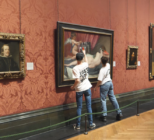Excavations at the National Gallery have revealed that the urban center of Saxon London extended further west than previously thought.
The excavations have been undertaken as part of the National Gallery’s ‘NG200: Welcome’, a redevelopment project forming part of the Gallery’s Bicentenary celebrations.
Findings at the dig include a hearth, postholes, stakeholes, pits, ditches and levelling deposits, which the Gallery said suggest the reworking of fence lines and evolving property boundaries in the Anglo-Saxon settlement which would become London.
Archaeologists from Archaeology South-East, part of the UCL Institute of Archaeology have released a report from excavations of Jubilee Walk, part of the National Gallery at the north end of Trafalgar Square, detailing the findings.
The National Gallery created Jubilee Walk – a walkway linking Trafalgar Square and Orange Street (for onward access to Leicester Square) – when it built the Sainsbury Wing in 1991.
Stephen White, who led the Jubilee Walk excavations for Archaeology South-East, said: “The evidence we uncovered suggests the urban centre of Lundenwic extends further west than originally thought. This was made all the more exciting by having the chance to share that information, and how it relates to archaeology across London, with young people from this city.”
Sarah Younger, Director of the NG200 Welcome Project, added: “It’s an honour for the National Gallery to be part of a discovery like this, and it brings home to us how everything we are building and re-constructing as part of this project will be part of the fabric and history of London for centuries to come.
“We are grateful for the hard work and care of the archaeologists who have worked with us over the past months, and, together with our site managers Sir Robert McAlpine LTD, have been bringing groups of students and young people to engage them in archaeology through their work with us. It’s shown to us that the enriching history of the National Gallery does not start and stop at the collection that hangs inside our walls.”










